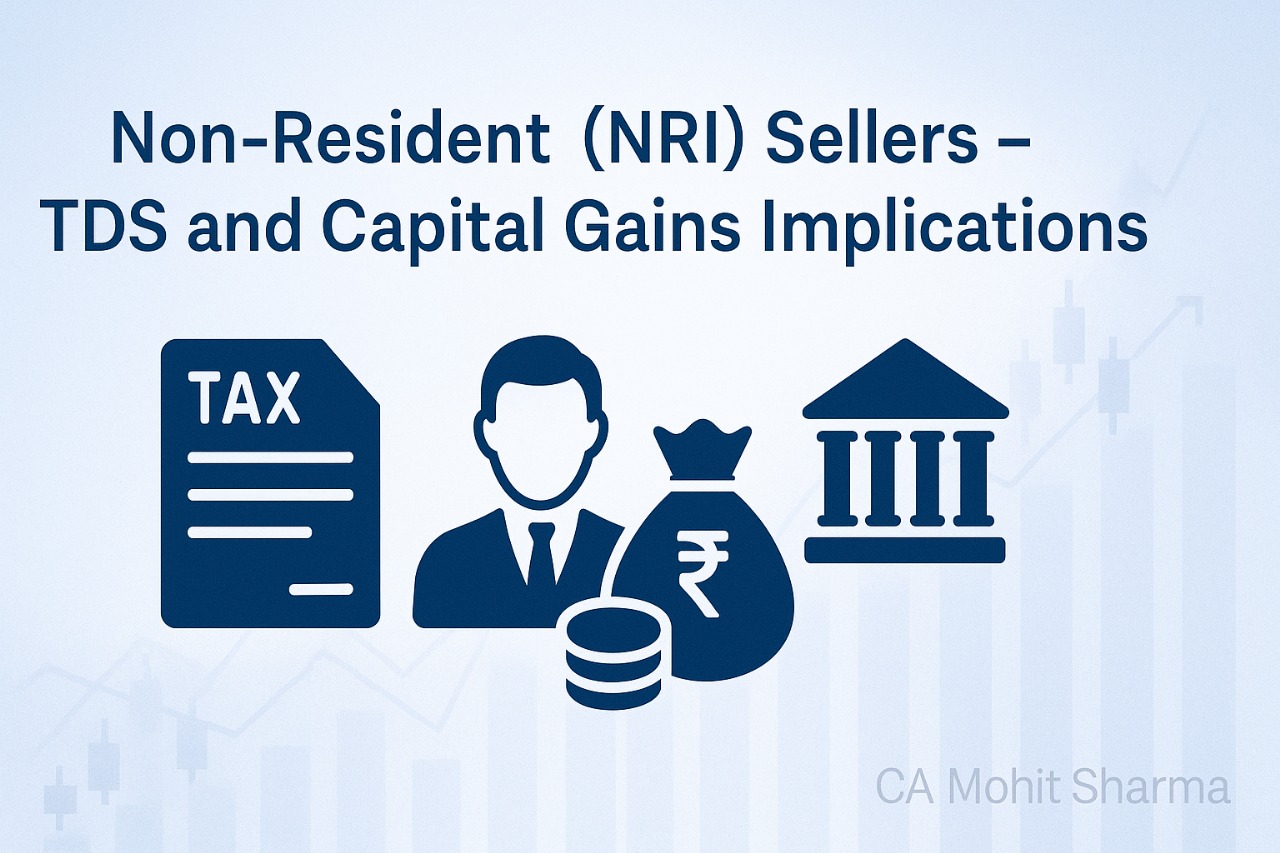
15 May Non-Resident (NRI) Sellers – TDS and Capital Gains Implications
Non-Resident (NRI) Sellers – TDS and Capital Gains Implications
If the property seller is an NRI (Non-Resident Indian), the tax law requires a higher TDS to ensure capital gains tax is collected from the sale. The process works as follows:
- TDS on Sale (Section 195): When a resident buys property from an NRI, the buyer must deduct TDS under Section 195. There is no ₹50 lakh threshold – TDS applies regardless of sale price. The applicable TDS rate is much higher than 1%:
- For long-term capital assets (property held ≥24 months), TDS is typically 20% of the sale price, plus surcharge and cess as applicable. (With the new rule, this effectively becomes 20% with indexation or 12.5% without indexation on long-term gains; however, since the buyer cannot compute the exact gain easily, they usually apply it on the full sale consideration by default.) In practice, many buyers now use 12.5% + surcharge/cess on the whole amount for long-term sales, reflecting the new LTCG rate.
- For short-term holdings (<24 months), the NRI’s gain is taxed at the normal slab rates. To be safe, buyers deduct TDS at 30% of the sale price (the highest slab rate) plus surcharge/cess. This ensures sufficient tax is withheld since short-term gains could push the NRI into the highest tax bracket.
- Buyer’s Compliance (TAN and Form 27Q): Unlike Section 194-IA, here the buyer must obtain a TAN (Tax Deduction Account Number) and cannot use the simple Form 26QB. TDS is deposited on a monthly basis and a quarterly TDS return (Form 27Q) is filed for these NRI transactions. The buyer issues a Form 16A TDS certificate to the NRI seller. Essentially, purchasing from an NRI involves more paperwork for the buyer, who must ensure the correct TDS is deducted and reported to avoid penalties.
- Actual Capital Gains Tax for NRI: The NRI seller’s actual tax liability on the capital gain is calculated the same way as for residents – short-term gains taxed at slab rates, long-term gains at 20% (or 12.5% without indexation as per new rule). Importantly, NRIs are also eligible for capital gains exemptions like Section 54, 54F, 54EC, etc., provided the reinvestment is in India. For example, an NRI can save tax by buying a new house in India within the stipulated time to claim Section 54 (just as a resident can). The challenge is that TDS might have been deducted upfront on the full sale amount, so the NRI may end up with more TDS than their final tax due.
- Lower TDS Certificate: To avoid over-deduction, an NRI seller can apply to the Income Tax Department for a Lower Deduction Certificate (LDC) before the sale. This certificate specifies a lower TDS rate (or amount) based on the estimated capital gain. If the NRI can show, for instance, that the actual taxable gain is only ₹X (after considering purchase cost and reinvestment plans), the tax officer might issue a certificate directing the buyer to deduct TDS only on that ₹X (at 20% or applicable rate) instead of the entire sale price. Obtaining this certificate (via Form 13 on the tax portal) can take a few weeks, so planning ahead is key. If no such certificate is obtained, the buyer will deduct tax on the gross amount as described, and the NRI can later file a tax return to claim refund of any excess TDS after calculating actual capital gains and applicable exemptions.
Example (NRI Seller): Anjali, an NRI residing in the US, sells her inherited plot in India for ₹1 crore in August 2025. She bought (or inherited) this property well over 2 years ago, so it’s a long-term asset for tax purposes. TDS for NRI sale: The buyer must deduct roughly 20% of ₹1 crore = ₹20 lakh as TDS (plus surcharge since ₹1 crore exceeds ₹50 lakh; e.g. 15% surcharge on LTCG brings effective TDS to ~23.92%, so about ₹23.9 lakh withheld). If Anjali’s actual indexed cost is high or she reinvests the proceeds into another house, her actual tax payable might be much lower. To avoid a huge upfront cut, Anjali could apply for a lower TDS certificate. Let’s say the tax authority determines her estimated capital gain is only ₹30 lakh (due to a high purchase cost and planned reinvestment under Section 54). They might issue a certificate to deduct TDS only on ₹30 lakh. Then the buyer would deduct ₹6 lakh (20% of ₹30 lakh) instead of ₹20+ lakh on the full price. If she didn’t get the certificate in time, the buyer would deduct the full ₹20+ lakh. Anjali would then file an Indian tax return showing her actual taxable gain and claim a refund for the excess TDS. Either way, she must report the sale in India. This example highlights that while the buyer’s TDS obligation is heavy in NRI transactions, the NRI seller’s final tax is still based on actual gains (with credit given for the TDS).

No Comments